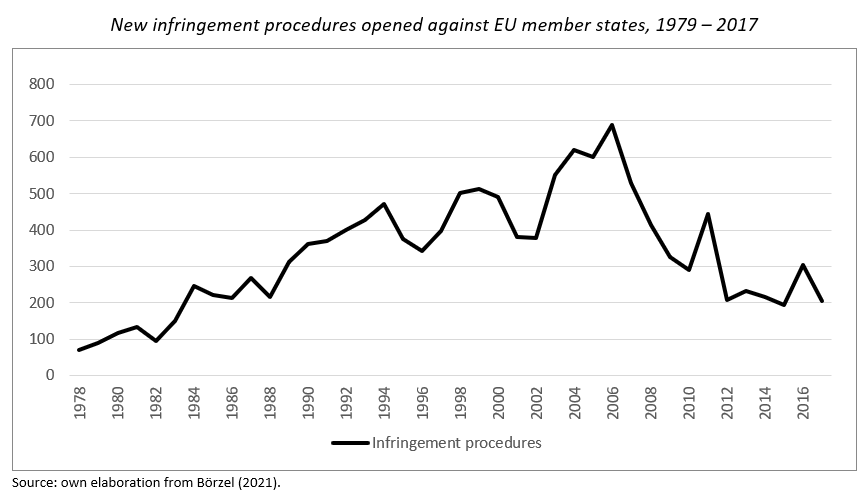Beyond differentiated integration (internal DI), various other forms of flexible integration are available to address heterogeneity problems within the European Union: flexible implementation, experimentalist governance, and a range of other tools. Some of them are complementary to country-based differentiation while others are alternative to it, representing rival means to achieve similar goals. The fourth chapter of this manual provides a brief overview of their features as well as some recommendations on their possible use and design.
Flexible implementation
Rather than introducing differentiations for specific countries, EU legal instruments can introduce more general forms of flexibility in the pursuit of given goals. On the one hand, national authorities can be granted legislative discretion in the transposition of EU directives and in the implementation of EU regulations. Various types of discretion are possible: (1) elaboration discretion, which allows states to further specify a provision; (2) reference to national legal norms, which allows a reliance on pre-existing national laws to define the scope or meaning of specific provisions; (3) minimum harmonization, which allow states to adopt more stringent legal standards; (4) scope discretion, which allow states to expand or restrict the cases to which a provision applies; (5) application discretion, which allows stated to deviate from a provision in individual cases. On the other hand, supranational and national authorities typically retain a certain degree of executive and administrative discretion in the application of abstract legal norms to concrete factual circumstances. In addition, they are sometimes formally granted the possibility to deviate from EU norms in specific situations: for instance, the Treaties contain several safeguard and derogation clauses which can be unilaterally activated by member states, while the Stability and Growth Pact contains two flexibility clauses, which must however be expressly authorized by the Commission and the Council.
The empirical patterns of flexible implementation can be explored with the FIEU dataset. Over the period 2006–2015, discretion affected around 26 per cent of all provisions in new EU directives, with particularly high values in the fields of justice and social policy and a prevalence of elaboration discretion (40 per cent) and references to national law (23 per cent). At the same time, around a third of discretions were subjected to legal constraints, particularly substantive and reporting ones (65 per cent). The potential of discretion in encouraging experimentation and innovation rarely materializes, as it is mainly used by states to retain existing policy arrangements. Directives containing many formal opt-outs tend to contain many discretion clauses: this suggests that flexible integration is complementary to differentiated integration and shares with it similar purposes and drivers. Finally, discretion does not seem to reduce non-compliance by national authorities, suggesting that its actual use is not sufficient to fully accommodate the underlying structural or political obstacles to further integration.
Therefore, we can formulate the following recommendations on the use and design of flexible implementation. Firstly, this tool should be considered alongside differentiated integration to address heterogeneity problems with general and nuanced legal solutions. Secondly, the use of flexible implementation may reduce the ambition of shared commitments and is less suitable in dealing with highly symbolic political issues. Thirdly, it should be designed in a way which minimizes legal uncertainty and accompanied by incentives to stimulate innovation and cross-border learning.
Experimentalist governance
Experimentalist governance provides an additional method of decision-making which can be used to deal with diversity in a context of supranational integration. Unlike conventional hierarchical governance, experimentalist governance puts in place a process of recursive goal setting and revision based on local experimentation, and mutual learning, and joint deliberation. Typically, it involves the creation of a multi-level architecture (e.g. EU institutions and national authorities) linking four elements in an iterative cycle: the agreement of provisional framework goals and metrics (e.g. good water quality) between all actors involved; the granting of a large autonomy and discretion to local actors to pursue those goals with their preferred means; regular reporting and peer review of their performance, leading to policy learning and appropriate corrective measures; and a periodic revision of goals, metrics, and procedures on the basis of the strengths and weaknesses revealed by the process. More recently, more simplified experimentalist architectures have emerged which combine synchronic uniformity with diachronic revisability, reducing the margins of discretion for local actors at any given moment but maintaining a process of revision of rules over time based on deliberation and mutual learning. Both types of experimentalism are widely used in the European Union across a range of policy domains: for instance, industrial regulation, food safety, environmental protection, social inclusion, justice, and fundamental rights.
Experimentalist governance can be introduced in all kinds of integration schemes, mostly acting as an alternative to the use of legal uniformity and country-based differentiations. Compared to uniform integration, it allows to take into account the heterogeneity of national conditions and to foster innovation. Compared to differentiated integration, it avoids a binary divide between insiders and outsiders and fine-tune commitments in a graduated manner similar to that foreseen by flexible implementation. However, it can sometimes coexist with the other two forms of integration, helping to improve the quality of uniform rules in the regulation of highly interdependent and uncertain sectors (e.g. energy regulation) or becoming possible only as a result of preliminary opt-outs of countries with fundamentally divergent preferences (e.g. Banking Union).
In terms of recommendations, experimentalist governance seems to be particularly useful in tacking policy problems where member states broadly agree on the desired aims and outcomes but the specific form, means, and pace of their attainment cannot be easily stipulated in a uniform manner: for instance, when adaptations to local conditions and traditions or to a rapidly changing external context are required or when equally valid solutions are available or must be discovered in the problem-solving phase. However, it should be accompanied by compensatory measures (e.g. fiscal transfers, technical support) or temporary differentiations (e.g. transitory exemptions) when the heterogeneity of capacities is bound to affect the performance of states willing but unable to reach the common goals. On the other hand, experimentalist governance does not seem to be helpful when member states hold fundamentally divergent preferences on the desirable goals to be pursued: in this case, differentiated integration is likely to yield markedly superior outcomes.
Other tools
Finally, a range of tools can be employed to accommodate diversity in the European Union.
If objections to an integration scheme depend on the special conditions or preferences of limited territorial areas, sub-national differentiations can be introduced to address their needs while avoiding unnecessary national opt-outs or no integration. This tool is widely used across policy areas. Several special territories are granted wide-ranging or complete derogations from EU law: nine outermost regions (OMT), such as Guadeloupe; thirteen overseas countries and territories (OCT) which are not considered part of the EU, such as Greenland; and ten special cases, such as Ceuta and Melilla. In addition, sub-national territories of third countries are sometimes granted a selective external integration in the EU: for instance, Northern Ireland. EU cohesion policy classify all sub-national territories in three distinct categories (less developed regions, transition regions, more developed regions): the former, in particular, enjoys a privileged status in the distribution of EU funds and special derogations to EU norms. The EU also encourages the territorial cooperation between regions, particularly cross-border ones, with specific programmes (e.g. INTERREG) and legal instruments (e.g. the European Grouping of Territorial Cooperation).
Fundamental disagreements on the desirable degree and content of European integration can also be solved with looser forms of voluntary cooperation, leaving countries free to determine the content of their national laws and policies according to their specific preferences and to voluntary coordination processes. More specifically, it allows states to freely determine their level, form, and pace of cooperation, unilaterally increase or decrease their commitments, and flexibly adapt to changed internal or external circumstances. It is widely used in areas lying beyond the competences and activity of the European Union and whenever EU law only imposes weak minimum standards, vague orientations, or non-binding commitments. This tool has both advantages and disadvantages, which mirror in a radicalized form those of differentiated integration. On the one hand, it provides a potentially attractive solution for dealing with a wide range of problems which are either unsuitable to uniform regulation, are politically controversial, cannot be legally handled within the framework of EU law without formally amending the Treaties, or entail commitments whose constitutionalization in entrenched international legal instruments is rejected for democratic or pragmatic reasons. On the other hand, it undermines the negotiation of stable and credible commitments, the achievement of uniform outcomes, the provision of common goods, and the avoidance of externalities.
The inability or unwillingness to comply with existing international commitments can also be accommodated with non-compliance. While it is typically more difficult to violate EU norms compared to international ones, in light of their primacy and direct effect and of the presence of effective enforcement mechanisms against reluctant countries (e.g. financial penalties), incomplete or delayed compliance with particularly complex, detrimental, or controversial norms is not uncommon. The BID dataset, for instance, shows that 13,367 infringement procedures against member states were opened by the Commission between 1978 and 2017, for an average of 334 procedures per year; after reaching a peak of 688 in 2006, they declined to 204 in the last year under consideration. Moreover, the dataset only identifies the tip of the iceberg of the phenomenon and does not fully capture its actual magnitude in several policy areas, such as European fiscal governance, the Dublin and Schengen regimes, or democratic backsliding in Hungary and Poland. Non-compliance can represent a very effective form of flexibility for individual member states, but it is of course illegal and undermines the credibility of negotiated commitment. Scholars have often suggested that all other forms of differentiated and flexible integration may help to reduce this problem, but recent analyses indicate that this may not be the case.

Finally, rather than by using differentiation and flexibility, objective or political obstacles to the negotiation and implementation of integration schemes can often be addressed by adopting uniform rules with compensatory mechanisms, such as fiscal transfers or technical assistance. These are fairly common in the European Union: for instance, the disruptive and unequal impact of market integration has repeatedly led to the introduction of direct compensatory policies (e.g. Common Agricultural Policy, Cohesion Policy, Next Generation EU) and countries with specific concerns routinely manage to extract side payments in package deals (e.g. EU budget rebates, location of EU institutions and agencies, increased funding for specific policies). Compensatory mechanisms are an excellent alternative to differentiated integration whenever uniform integration yields high overall benefits but produces serious problems in selected countries or an excessively unbalanced distribution of individual costs and benefits. On the other hand, they are not useful in situations characterized by zero-sum games, fundamentally divergent preferences, or threats to vital national interests. It must also be reminded that all forms of differentiation and flexibility not relying on the unanimous consent of all parties tend to undermine the ability of opposing states to extract compensatory payments, thereby increasing the likelihood of negative externalities and decreasing the legitimacy and acceptance of the outcome.
